Also in series
Reviews View More
I actually wrote this game off as a Snake's Revenge type situation a long time ago and never bothered to even acknowledge it let alone give it a try. But this game actually fucking rocks. Maybe I'm just a sucker for graze but energy mode feels very satisfying to play and the scoring mechanics manages to avoid a lot of the tedium I usually dislike. Say what you will, it's the game that convinced CAVE to stay in the arcade business.
Bee Storm is fundamentally misunderstood, and it’s easy to get why. It’s the sequel to one of the most renowned shooting games in one of the most renowned shooting series—by CAVE, the most renowned of shooting game devs—but it was not made by CAVE, it feels nothing like a CAVE game, and in fact it only coheres with the rest of the Dodonpachi series in its ship, environment and enemy designs (as well as—vaguely—in its combo scoring mechanic). It’d be incredibly easy to play it after trying the original DDP, glimpse its sludgy, basic bullet patterns, its knockoff sprites, and its sloppier combo system, write it off as a half-baked cash-in on a moderately popular IP by Taiwanese developer IGS, and move on.
To do so, however, would be to miss a truly divine game — one whose fun is hidden a few layers below its surface, admittedly, but one that nevertheless, in my opinion at least, stands with the best and most satisfying games in the genre. That’s right. Bee Storm — the fucking meme game — is one of the better shmups of all time.
Here’s why:
1. Grazing. Bee Storm has two modes — Bomb mode, and Energy mode. The former is the mode that most clearly resembles other games in the series, and is therefore the one that players would naturally try first: you start out with a stock of bombs, collect others from destroyed enemies, and use them to help you clear the screen of bullets and do big damage. It’s shmups 101.
The reason that the game is written off so quickly by most players, though, is that Bomb mode sucks and is boring. Stock is too plentiful, and the bombs do nothing to help increase or maintain combo. The game simply is not designed around this mechanic, and I suspect it was added late in development to get DDPII more in line with its predecessors.
So where does grazing come in? Energy mode. This is the real shit. In this mode, when you get close to bullets, you charge an energy gauge that you can then release as a huge laser, not only dealing heavy damage but also (if targeting a large enemy especially) putting your combo into overdrive. Additionally, you're granted a period of about 3 seconds of invulnerability, in which—crucially—you can dive into clouds of bullets and quick-charge your gauge all over again.
I could write forever about what a beautiful and satisfying and perfect system this is, but I’ll try to keep it simple: as the game gets more difficult, it becomes more about charging your laser as quickly as possible and unleashing it, over and over. As I played this way more, and as I learned the game and its patterns and stage layouts, I could tell with striking clarity that this is the way it was meant to be played. Where once I saw these rather mundane-seeming and at times odd clusters of bullets that make little sense in normal bullet-hell dodging context, I now see them as ammunition for my laser, and in that context the game’s incredibly tight design locks into place. Stage 5 is the most concrete example, where swarms of small enemies swoop low on the screen and quickly unleash dense, hatched lines of bullets, which you can hurl yourself into during your i-frames after lasering to immediately get a second charge. You can do this over, and over, and over throughout this level in particular, and throughout the game as a whole; and it feels amazing.
2. Aura / Scoring. The aura returns from Dodonpachi – essentially a halo around the player’s ship that manifests while lasering (holding the shot button instead of rapid tapping), and that deals crazy damage when held against an enemy. The cool thing is that, in Bee Storm, it also sends your combo into the stratosphere, and thus the game really encourages you to get up close to bosses and find safe spots to hang out in, and aura the hell out of them for intensely huge, gratifying point gains.
Which leads me to say: if you haven't, play Bee Storm for score! If you’re only interested in a survival clear, Energy mode can still be really fun, but it may become a notch or two less interesting. If you gun for those 9999 end-of-level combos though, every stage is a pure adrenaline rush: a potent blend of twitch action and studious, thoughtful play to find the best points at which to aura and laser-bomb and maximize the amount of score you can wring out of enemy patterns and bosses.
Add to this that the combo system from DDP has been made much more lenient– your combo simply decreases rapidly instead of dropping to zero when not being actively added to. Stages can therefore be combo'd more organically than in the rigid DDP and DOJ, and missing one scoring strat can be made up for by nailing another later. If you really want to go advanced-mode, you could also try remaining underpowered, which allows enemies and bosses to hang around longer to be milked for score. It’s all got great flow and impressive balance if you marinate in it a while–something that the game’s unfortunately hastily garnered reputation has obscured.
3. Shot type diversity. Isn’t it rather annoying to have to commit to a single shot type (wide vs. narrow, e.g.) and ship speed for an entire playthrough, as you have to in most modern shmups? Bee Storm says fuck that, and allows you to cycle through each of its three variations during a run by pressing the Start button. I love to mostly stay in narrow formation with quick speed, darting back and forth through enemy fire for graze; but it’s fantastic to be able to resort to the screen-control-friendly wide shot when necessary. (I didn’t find much use for the second, middle ship type throughout the game, except during the true last boss fight, where, for me, it provided the perfect speed to weave through the massive number of bullets and graze for countless devastating lasers).
4. Safe spots. One common criticism leveled against the game is that it’s janky for having so many spaces to hide from enemy fire, especially during boss fights. To which I say: what’s the big deal? As someone who cleared the game with a decently high score not by watching replays but through my own repetitious playing and learning, figuring out where these spots were and exploiting them was a massive part of the game’s charm. I’ll go even further to say that I think many if not all of them exist for a specific reason, for scoring potential or to take advantage of the aforementioned laser-charges during i-frames. They don’t feel haphazard, or detrimental to the game’s balance, at all; rather, they give it an extra dimension on top of its other already-compelling systems.
5. Level diversity. Having different gameplay ‘themes’ across different stages is a relatively common thing in shmups, but you’d probably not expect to find such a pristine example of it in a game as widely mocked as Bee Storm:
Stage 1. A simple boss fight introduces the graze mechanic with highly linear, train-rail bullet patterns, and provides a cool opportunity to puzzle out how best to take it apart for maximum score (seeing as you’ll be playing it many, many times).
Stage 2. A more conventional shmup stage that introduces tight combo maintenance with a blend of popcorn enemies and larger tanks that can be aura’d. Perhaps the most DoDonPachi-style stage, with a boss that’s easily defeated but that has significant score milking potential.
Stage 3. An almost Garegga-esque stage, with wave after wave of giant ships to take out, each with multiple turrets and with popcorn enemies in tow. Here the gameplay differs greatly from stage 2, overwhelming you with bullets quickly, forcing you to bomb and providing clear and enticing opportunities to recharge. The boss is all about disassembly, piece by piece.
Stage 4. Here, ground enemies are the highlight, with tanky robots and fencing structures providing tricky barriers to your shots penetrating further upscreen. The boss features waves of ultra-fast spread patterns, the likes of which don’t really show up anywhere else in the game.
Stage 5. This is the aforementioned laser-bomb-fest, where the way that enemies are laid out (especially in the latter half of the stage) allows you to continually hurl yourself into fire while invincible, dodge for an agonizing 4-5 seconds while the bar recharges, and then unleash all over again. The boss of this stage is the best in the game, teasing you with major aura opportunities but punishing you if you get complacent.
Stage 6. A tough-as-nails, classic exercise in pure dodging. True bullet hell, with a nasty final boss to match.
Stage 7. A true last boss that you only reach if you exceed 400,000,000 points – a brilliant decision from the designers that forces you to reckon with the game’s scoring structure (and hopefully recognize the fun in it!) if you want to experience all of its content.
If it isn’t already abundantly clear, I like this game a lot. I was extremely tempted to give it a perfect 5, which would put it above the original DDP and its lauded successor DOJ in my personal ranking; but after considering it more, I think that’s a bit much. To me, DDP2 simply sits right alongside its series brethren. It sports different mechanics, sure, but it’s absolutely an equally-thrilling dopamine rush, if you’re willing to look past all of the hasty naysaying and some clunky spritework and music, and find it.
To do so, however, would be to miss a truly divine game — one whose fun is hidden a few layers below its surface, admittedly, but one that nevertheless, in my opinion at least, stands with the best and most satisfying games in the genre. That’s right. Bee Storm — the fucking meme game — is one of the better shmups of all time.
Here’s why:
1. Grazing. Bee Storm has two modes — Bomb mode, and Energy mode. The former is the mode that most clearly resembles other games in the series, and is therefore the one that players would naturally try first: you start out with a stock of bombs, collect others from destroyed enemies, and use them to help you clear the screen of bullets and do big damage. It’s shmups 101.
The reason that the game is written off so quickly by most players, though, is that Bomb mode sucks and is boring. Stock is too plentiful, and the bombs do nothing to help increase or maintain combo. The game simply is not designed around this mechanic, and I suspect it was added late in development to get DDPII more in line with its predecessors.
So where does grazing come in? Energy mode. This is the real shit. In this mode, when you get close to bullets, you charge an energy gauge that you can then release as a huge laser, not only dealing heavy damage but also (if targeting a large enemy especially) putting your combo into overdrive. Additionally, you're granted a period of about 3 seconds of invulnerability, in which—crucially—you can dive into clouds of bullets and quick-charge your gauge all over again.
I could write forever about what a beautiful and satisfying and perfect system this is, but I’ll try to keep it simple: as the game gets more difficult, it becomes more about charging your laser as quickly as possible and unleashing it, over and over. As I played this way more, and as I learned the game and its patterns and stage layouts, I could tell with striking clarity that this is the way it was meant to be played. Where once I saw these rather mundane-seeming and at times odd clusters of bullets that make little sense in normal bullet-hell dodging context, I now see them as ammunition for my laser, and in that context the game’s incredibly tight design locks into place. Stage 5 is the most concrete example, where swarms of small enemies swoop low on the screen and quickly unleash dense, hatched lines of bullets, which you can hurl yourself into during your i-frames after lasering to immediately get a second charge. You can do this over, and over, and over throughout this level in particular, and throughout the game as a whole; and it feels amazing.
2. Aura / Scoring. The aura returns from Dodonpachi – essentially a halo around the player’s ship that manifests while lasering (holding the shot button instead of rapid tapping), and that deals crazy damage when held against an enemy. The cool thing is that, in Bee Storm, it also sends your combo into the stratosphere, and thus the game really encourages you to get up close to bosses and find safe spots to hang out in, and aura the hell out of them for intensely huge, gratifying point gains.
Which leads me to say: if you haven't, play Bee Storm for score! If you’re only interested in a survival clear, Energy mode can still be really fun, but it may become a notch or two less interesting. If you gun for those 9999 end-of-level combos though, every stage is a pure adrenaline rush: a potent blend of twitch action and studious, thoughtful play to find the best points at which to aura and laser-bomb and maximize the amount of score you can wring out of enemy patterns and bosses.
Add to this that the combo system from DDP has been made much more lenient– your combo simply decreases rapidly instead of dropping to zero when not being actively added to. Stages can therefore be combo'd more organically than in the rigid DDP and DOJ, and missing one scoring strat can be made up for by nailing another later. If you really want to go advanced-mode, you could also try remaining underpowered, which allows enemies and bosses to hang around longer to be milked for score. It’s all got great flow and impressive balance if you marinate in it a while–something that the game’s unfortunately hastily garnered reputation has obscured.
3. Shot type diversity. Isn’t it rather annoying to have to commit to a single shot type (wide vs. narrow, e.g.) and ship speed for an entire playthrough, as you have to in most modern shmups? Bee Storm says fuck that, and allows you to cycle through each of its three variations during a run by pressing the Start button. I love to mostly stay in narrow formation with quick speed, darting back and forth through enemy fire for graze; but it’s fantastic to be able to resort to the screen-control-friendly wide shot when necessary. (I didn’t find much use for the second, middle ship type throughout the game, except during the true last boss fight, where, for me, it provided the perfect speed to weave through the massive number of bullets and graze for countless devastating lasers).
4. Safe spots. One common criticism leveled against the game is that it’s janky for having so many spaces to hide from enemy fire, especially during boss fights. To which I say: what’s the big deal? As someone who cleared the game with a decently high score not by watching replays but through my own repetitious playing and learning, figuring out where these spots were and exploiting them was a massive part of the game’s charm. I’ll go even further to say that I think many if not all of them exist for a specific reason, for scoring potential or to take advantage of the aforementioned laser-charges during i-frames. They don’t feel haphazard, or detrimental to the game’s balance, at all; rather, they give it an extra dimension on top of its other already-compelling systems.
5. Level diversity. Having different gameplay ‘themes’ across different stages is a relatively common thing in shmups, but you’d probably not expect to find such a pristine example of it in a game as widely mocked as Bee Storm:
Stage 1. A simple boss fight introduces the graze mechanic with highly linear, train-rail bullet patterns, and provides a cool opportunity to puzzle out how best to take it apart for maximum score (seeing as you’ll be playing it many, many times).
Stage 2. A more conventional shmup stage that introduces tight combo maintenance with a blend of popcorn enemies and larger tanks that can be aura’d. Perhaps the most DoDonPachi-style stage, with a boss that’s easily defeated but that has significant score milking potential.
Stage 3. An almost Garegga-esque stage, with wave after wave of giant ships to take out, each with multiple turrets and with popcorn enemies in tow. Here the gameplay differs greatly from stage 2, overwhelming you with bullets quickly, forcing you to bomb and providing clear and enticing opportunities to recharge. The boss is all about disassembly, piece by piece.
Stage 4. Here, ground enemies are the highlight, with tanky robots and fencing structures providing tricky barriers to your shots penetrating further upscreen. The boss features waves of ultra-fast spread patterns, the likes of which don’t really show up anywhere else in the game.
Stage 5. This is the aforementioned laser-bomb-fest, where the way that enemies are laid out (especially in the latter half of the stage) allows you to continually hurl yourself into fire while invincible, dodge for an agonizing 4-5 seconds while the bar recharges, and then unleash all over again. The boss of this stage is the best in the game, teasing you with major aura opportunities but punishing you if you get complacent.
Stage 6. A tough-as-nails, classic exercise in pure dodging. True bullet hell, with a nasty final boss to match.
Stage 7. A true last boss that you only reach if you exceed 400,000,000 points – a brilliant decision from the designers that forces you to reckon with the game’s scoring structure (and hopefully recognize the fun in it!) if you want to experience all of its content.
If it isn’t already abundantly clear, I like this game a lot. I was extremely tempted to give it a perfect 5, which would put it above the original DDP and its lauded successor DOJ in my personal ranking; but after considering it more, I think that’s a bit much. To me, DDP2 simply sits right alongside its series brethren. It sports different mechanics, sure, but it’s absolutely an equally-thrilling dopamine rush, if you’re willing to look past all of the hasty naysaying and some clunky spritework and music, and find it.
Fucking snoozefest for the 4 first stages then they somehow made hall of hell worse THEN they made Stage 6 twice as long AND THEN the final boss is piss easy.
TLB and energy mode are kinda cool but this can't save this direct downgrade of DDP, and I don't even like DDP that much.
It's easy enough without the TLB so it's an okay first 1-All for someone getting into the genre but why would you recommend someone Bee Storm aaaaaaah
Still better than Touhou 6.
TLB and energy mode are kinda cool but this can't save this direct downgrade of DDP, and I don't even like DDP that much.
It's easy enough without the TLB so it's an okay first 1-All for someone getting into the genre but why would you recommend someone Bee Storm aaaaaaah
Still better than Touhou 6.





